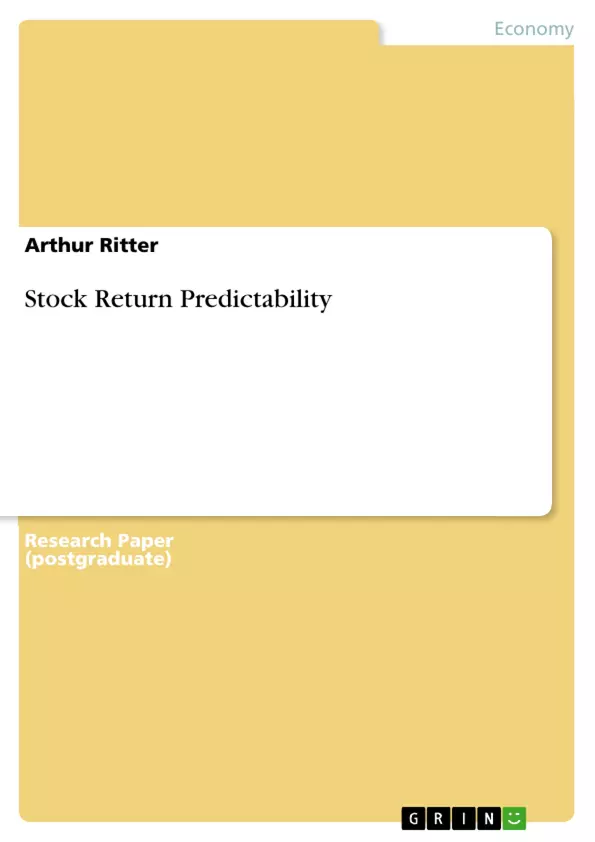Empirical evidence of stock return predictability obtained by financial ratios or macroeconomic factors has received substantial attention and remains a controversial topic to date. This is no surprise given that the existence of return predictability is not only of interest to practitioners but also introduces severe implications for financial models of risk and return. Founded on the assumption of efficient capital markets, research on capital asset pricing models has instigated this emergence of stock return predictability factors. Analysing these factors categorically, this paper will provide a balanced discussion of advocates as well as sceptics of stock return predictability. This essay will commence by firstly outlining the fundamental assumptions of an efficient capital market and its implications for return predictability. Subsequently, a thorough focus will be placed on the most significant predictability factors, including fundamental financial ratios and macroeconomic indicators as well as the validity of sampling methods used to attain return forecasts. Lastly this essay will reflect on the findings while proposing areas of further research.
Inhaltsverzeichnis (Table of Contents)
- Introduction
- Predictability and Efficient Capital Markets
- Price-to-Earnings Ratio
- Dividend Yield
Zielsetzung und Themenschwerpunkte (Objectives and Key Themes)
This paper investigates the controversial topic of stock return predictability, analyzing its implications for financial models of risk and return, and exploring the arguments of both advocates and skeptics. The paper begins by outlining the fundamental assumptions of an efficient capital market and its implications for return predictability. It then focuses on key predictability factors, including fundamental financial ratios and macroeconomic indicators, while examining the validity of sampling methods used to attain return forecasts. Lastly, the paper reflects on the findings and proposes areas for further research.
- The relationship between stock return predictability and the efficient market hypothesis
- The role of fundamental financial ratios, such as the price-to-earnings ratio and dividend yield, in predicting stock returns
- The impact of macroeconomic factors on stock return predictability
- The validity and limitations of sampling methods used to forecast stock returns
- Areas for future research in the field of stock return predictability
Zusammenfassung der Kapitel (Chapter Summaries)
Introduction
The paper introduces the topic of stock return predictability, highlighting its importance in understanding financial models of risk and return. The paper outlines the fundamental assumptions of an efficient capital market and its implications for return predictability, setting the stage for the subsequent discussion on predictability factors.
Predictability and Efficient Capital Markets
This section delves into the efficient market hypothesis (EMH) and its implications for stock return predictability. The paper discusses the three forms of EMH – weak, semi-strong, and strong – and the underlying premises of investor rationality, arbitrage, and collective rationality. The section also explores criticisms of the EMH, particularly the argument that market inefficiencies are necessary to compensate investors for the cost of trading and information gathering.
Price-to-Earnings Ratio
This section examines the price-to-earnings (P/E) ratio as a potential indicator of market valuations and its role in predicting stock returns. The paper reviews studies by Fama and French (1988), Keim (1990), and Bali et al. (2008), which highlight the significant explanatory power of the P/E ratio in understanding stock price movements. The section also discusses the relationship between the P/E ratio and future stock returns, considering the perspectives of Shiller (1984), Fama and French (1988), and Vanguard (2012).
Dividend Yield
This section focuses on the dividend yield (DY) as a potential predictor of future stock returns. The paper presents empirical evidence from studies by Rozeff (1984), Campbell and Shiller (1988), and Fama and French (1988), demonstrating the predictive power of DY in estimating future stock returns. The section also explores the relationship between DY and the return horizon, as well as the explanatory power of DY in forecasting future returns across different international markets.
Schlüsselwörter (Keywords)
The key concepts and themes explored in this paper include stock return predictability, efficient market hypothesis, financial ratios, macroeconomic indicators, price-to-earnings ratio, dividend yield, risk and return, and asset pricing models. The paper examines the relationship between these concepts and their implications for financial modeling and investment strategies.
- Citation du texte
- Arthur Ritter (Auteur), 2015, Stock Return Predictability, Munich, GRIN Verlag, https://www.grin.com/document/299133



